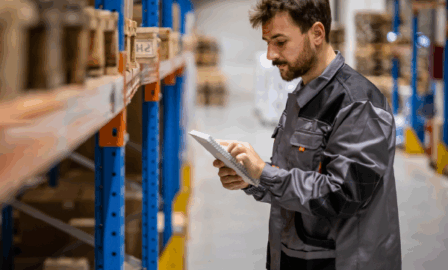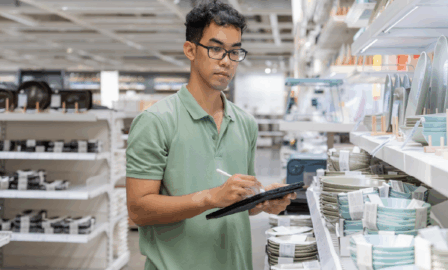Tariffs and the Retail Industry: What Retailers Need to Know
Tariff policies are currently in constant flux, leaving retailers and consumers unnerved. On April 2, the Trump Administration announced higher tariffs on around 60 countries and 10% tariffs on all other countries. This is all part of Trump’s “America First Trade Policy” that aims to make America’s economy stronger by bringing manufacturing to the U.S. and making tariffs more balanced between all countries. On April 9, many of the tariffs were put on a 90-day pause due to multiple countries wanting to negotiate with President Trump. For U.S. retailers, this can mean higher costs for imported goods, uncertainty in pricing, and a shift in consumer behavior.
Retailers will encounter increased costs and the possibility of fewer purchases from consumers; acting fast and being prepared with a strategy that can assist in lowering or eliminating the tariff costs is the best action for retailers to take. Retailers handled this problem before, eight years ago, when the Trump administration imposed new tariffs, and everything eventually did calm down. Retailers’ volatility and strategy within their supply chain allowed them to stay successful. The economic uncertainty now, however, is causing consumers to feel worried and pay more attention to spending habits. Here’s what retailers need to know about tariffs and the retail industry.
How Tariffs are Impacting Retailers and Customers
Rising Costs and Inflation
Tariffs are essentially taxes on imports, and more tariffs are being imposed by multiple countries. While tariffs are increasing, it’s unknown how permanent they will be; however, they still have significant impacts. Previous import tariffs in late 2018, according to research from the Journal of Economic Perspectives, were adding about $3.2 billion a month in extra costs to U.S. consumers and importers—with an additional $1.4 billion lost in economic efficiency. Now, estimates from the Federal Reserve Bank of Boston suggest that imposing an extra 25% tariff on goods from Canada and Mexico, along with a 10% tariff on Chinese goods, could increase core inflation by up to 0.8 percentage points (excluding food and energy). Given that Canada supplies the majority of America’s crude oil and Mexico a significant share of our fresh fruits and vegetables, the broader impact on prices could be even more pronounced and consumer price inflation will cause a shift in consumer behavior.
Shifting Consumer Behavior: Short- and Long-Term Impacts
Recent consumer sentiment data reveals:
- 83% of U.S. shoppers are aware of new or proposed tariffs.
- 80% are concerned about the effect on their finances.
- 76% anticipate changing their shopping habits.
- 64% worry about higher prices for everyday goods.
- 41% plan to hunt for sales or coupons to offset price increases.
Shoppers are facing immediate price increases, limited alternatives, and heightened sensitivity to promotions, impacting everyday spending. Supply chain issues may result in delays and a temporary reduction in product variety. While higher prices may become the new norm, market adjustments, including improved domestic sourcing, enhanced retailer strategies, and more stable supply chains, can lead to a more consistent and higher-value shopping experience. This is what this could mean for the long term:
Stabilized Pricing with a New Normal: Over time, the market may adjust so that higher prices, initially driven by tariff costs, become normalized. Retailers and suppliers will have had time to optimize their sourcing and pricing strategies, leading to more stable (but generally higher) price levels compared to the pre-tariff era. The impact of tariffs might be partially offset by enhanced value offerings, such as improved product quality or additional services that justify the higher price points, shifting consumer expectations toward quality and reliability.
Shift Toward Domestic and Nearshore Sourcing: As retailers increasingly source from domestic or nearshore suppliers to avoid tariff volatility, customers may see a higher proportion of American-made or regionally sourced products. This could benefit those who value local production and sustainability. With the supply chain stabilized through diversified and more localized sourcing, customers may experience fewer sudden price spikes, even if the overall price level remains elevated.
Evolving Retail Experiences and Innovation: Advances in technology, real-time data analytics, and dynamic pricing strategies may allow retailers to offer more personalized promotions. Customers could benefit from targeted discounts based on purchasing behavior, which might help offset higher baseline costs. Over the long term, the transition to diversified supply chains should lead to more reliable product availability, meaning consumers could benefit from a broader range of products, including a mix of imported and domestically produced goods, reducing the impact of global trade disruptions. Additionally, with sustained higher prices, customers may develop new habits, such as greater brand loyalty toward retailers that offer a consistent value proposition, and a higher willingness to pay for products that combine quality with strong after-sales support.
More Informed Consumer Choices: With ongoing changes in tariff policies, retailers may invest more in consumer education and transparent pricing strategies. Shoppers might become more aware of the reasons behind price changes and adjust their expectations accordingly. And, over time, as the market stabilizes, consumers may shift from focusing solely on short-term discounts to long-term budgeting for quality goods that have adjusted to the new cost base.
By understanding these dynamics, retailers can better prepare their strategies and communicate with customers, ensuring that both immediate disruptions and long-term changes are managed effectively to maintain a strong competitive position in the market.
Supply Chain and Sourcing Challenges
On April 9, President Donald Trump reduced country-specific tariffs down to a universal 10% rate for all trade partners except China. China’s tariff rate will jump to 125%, effective immediately. Beijing has announced a reciprocal 84% tariff rate on U.S. goods, effective April 10. This means retailers must rethink their supply chains to absorb some of the new tariff costs. With increased costs and uncertainty, sourcing products from alternative markets or even nearshoring production could help mitigate risks.
However, for products not available in the U.S., grocers are asking the Trump administration for exceptions on certain ingredients. Other retailers are negotiating with suppliers. Pricing is very involved with retailers, and it’s not as easy as just upping the prices of all products by a few dollars. Retailers know they can’t pass the price on to the consumers and lose market share; instead, they need to look at prices holistically to determine the right strategy. Diversifying prices on different product lines and/or raising wholesale prices will help balance the costs. Retailers do not want to absorb the tariffs’ full costs but can take lower margins and share them with suppliers and wholesalers. Using AI and predictive analytics can assist in mitigating risks and impacts of these fluid tariffs, specifically with supply chain and pricing.
Strategies for Retailers: How to Adapt and Thrive
1. Diversify Your Supply Chain
Diversifying your supply chain reduces reliance on any single market, helping to mitigate the risks associated with tariff fluctuations and supply disruptions while ensuring more stable pricing and reliable access to goods. Retailers can consider looking beyond traditional markets to source products from countries that aren’t subject to the same tariffs, not only reducing cost exposure but also minimizing reliance on a single region. Retailers may also consider sourcing more from domestic or nearshore suppliers. Although it may require changes to your supply chain, this approach protects a retailer from international tariff volatility by reducing dependency on imports subject to sudden tariff hikes, shortening the supply chain, lowering transportation costs, and mitigating risks associated with global trade disruptions.
2. Adjust Pricing and Promotion Tactics
This allows retailers to strike a balance between absorbing increased costs and maintaining customer affordability, ensuring that profit margins remain healthy while keeping shoppers engaged through targeted, data-driven promotions. The pricing, merchandising, and analytics teams should work together to adjust pricing and promotion tactics using real-time data from internal sales systems, eCommerce analytics, competitor tracking, and market research – and also continuously monitor these metrics to make necessary adjustments. Balancing cost absorption with price increases can help protect margins while maintaining customer loyalty. Additionally, implementing targeted promotions and discounts can help offset higher prices.
Some retailers have successfully used coupons or special offers to keep customers engaged even as tariffs drive up costs. While there are few publicly documented cases where companies have launched coupon programs exclusively in response to tariffs, several large retailers have successfully employed targeted promotions and coupon strategies during periods of rising input costs, which often include tariff pressures, as part of their broader pricing tactics. For example:
- Walmart and Target: While not exclusively tied to tariffs, both Walmart and Target have a long history of using strategic promotions and coupon programs (for example, price rollback promotions and dynamic discounting via their respective mobile apps) to help cushion price increases. Their experience in managing cost fluctuations, including those caused by tariffs, demonstrates how carefully calibrated coupon strategies can help maintain customer engagement during challenging economic times.
- Grocery Chains (e.g., Kroger): Grocery retailers frequently deploy coupons, loyalty discounts, and digital promotions to counteract rising costs on food and household items. These practices not only help offset the impact of tariffs on imported goods (such as fresh produce or imported consumer packaged goods) but also support customer retention by delivering value through savings.
- Chipotle: Chipotle has stated it would absorb some of the cost increases resulting from tariffs rather than passing all of those costs onto customers. In tandem with this, the chain has used targeted promotions (like digital coupons and special offers) to retain customer loyalty without negatively impacting overall sales.
3. Renegotiate and Rebalance Supplier Relationships
Renegotiating and rebalancing supplier relationships can help to lower tariff costs for retailers. This might look like speaking with current suppliers to renegotiate contracts or secure volume discounts, helping to lower the overall cost of goods. Retailers may also consider shifting toward suppliers that offer more favorable pricing or who are less affected by tariff hikes. This can help stabilize costs over the long term.
4. Cost Management and Operational Efficiency
Cost savings remain at top of mind for retailers during these uncertain times. Of course, retailers would prefer to avoid passing some of the costs onto the customer, but in reality, most retailers will absorb some of the cost (like Chipotle) and pass some of them onto customers and suppliers. In some cases, sharing the cost increase can protect profit margins without scaring off price-sensitive customers. Regardless, U.S. retailers will need to look for ways to improve efficiencies across the board, whether that means reducing overhead, optimizing logistics, implementing new technologies to cut costs, or pursuing other cost-saving measures.
5. Stay Informed and Agile
Tariff policies are being reconfigured daily and highlight the urgency of staying agile. Keeping a close eye on these changes and preparing for swift adjustments is essential to managing both short-term shocks and long-term shifts in consumer behavior and market dynamics.
Final Thoughts: Tariffs and the Retail Industry
Tariffs are more than just a policy tool; they’re a critical factor influencing pricing, consumer behavior, supply chains, and the larger retail industry as a whole. By diversifying your supply chain, adjusting pricing strategies, renegotiating supplier contracts, and improving operational efficiencies, U.S. retailers can better mitigate the impact of tariffs and continue to meet customer demand even in uncertain times.
Staying ahead of the curve is key. In an era of constant tariff adjustments and economic uncertainty, informed and agile retailers will be best positioned to weather the storm and emerge stronger. Talk to our retail experts today about ways we can support your journey to adapt to these changes and protect profit margins while also staying competitive in a rapidly shifting market.





